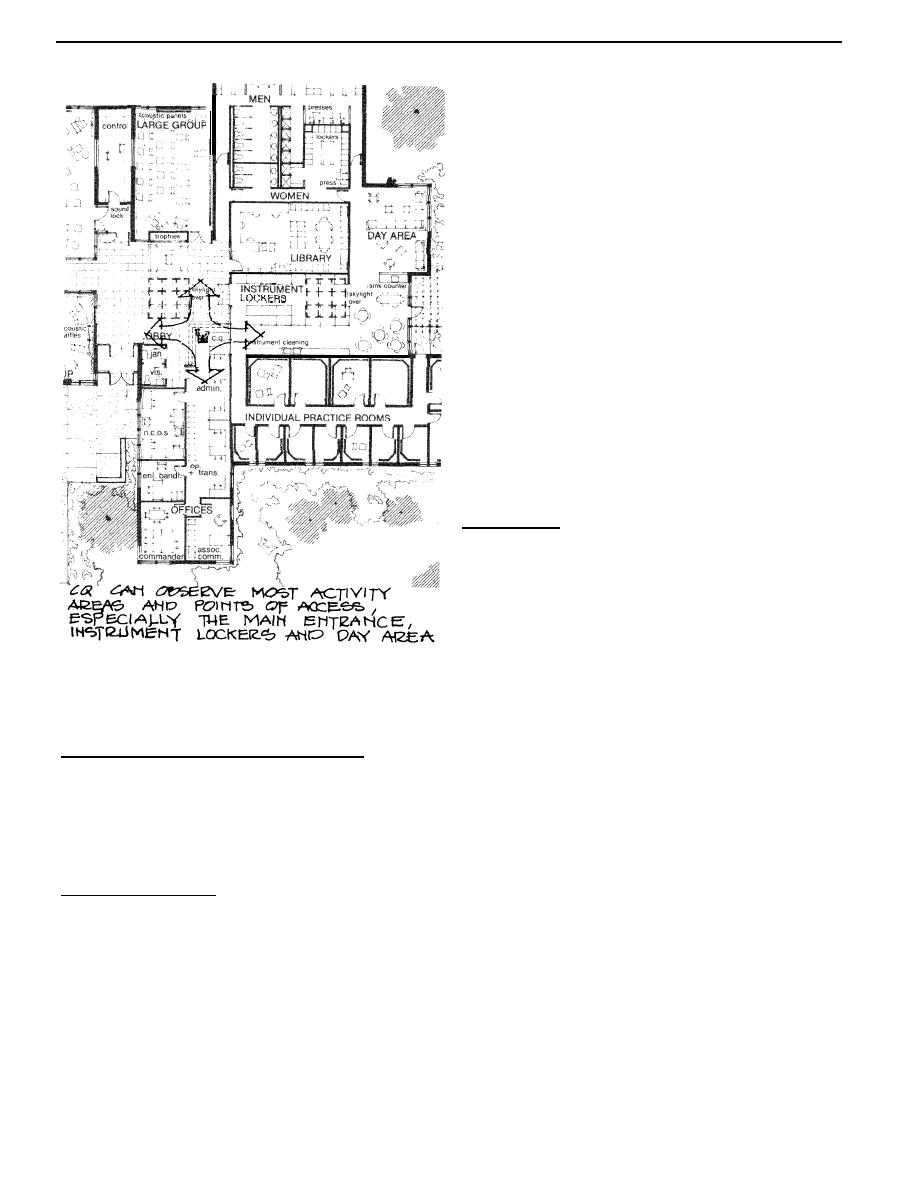
Design Guide: Band Training Facilities
DG-1110-3-119
General Design Programming
March 1983
is no better than the band's training and practice. This
can only be effective if band personnel can hear them-
selves and each other clearly, and be heard by the band-
master for instruction. Control of the quality of sound within
the music rooms, and of the ability to hear without dis-
traction from noise from other rooms, is essential.
This section sets forth the principles of design for acous-
tic quality and sound isolation, and their implications for build-
ing organization. Specific room descriptions based on
these principles are found in Chapter 4, and details for
construction to meet acoustic requirements are presented
in Chapter 5.
The three areas of concern in designing a functionally
suitable sound environment are:
Sound isolation-reducing or eliminating the passage
q
of unwanted sounds (noise) from other rooms into
sound-sensitive rooms;
Noise Control-the design of mechanical systems so
q
as to achieve sufficiently low and sufficiently even
background noise levels.
Room Acoustics-the quality of sound that bandsmen
q
generate and hear within their practice rooms.
A. Sound Isolation
1. Principles. In order for instruction and practice to be
effective, music practice rooms must be quiet and without
distraction from noise sources outside the room. Every
level of decision in the design and construction process has
an impact on how successfully unwanted sound (noise)
is kept out of music rooms, from the choice of structural
system and building organization to details such as the
installation of lighting fixtures.
The sound generated by bands includes low frequencies.
Figure 3-10. Supervision Relationships
Ordinary noise problems (notably speech) involve higher
frequencies, which can be attenuated (reduced) by rela-
tively light constructions. The primary method of compar-
"public" parts of the facility without going through the indi-
ing attenuation between different materials or assemblies
vidual Instrument Lockers/Day Area.
is by Sound Transmission Class (STC), which considers
8. Unit SuPDlv/Storaae/instrument Repair. These
performance from 125 to 4000 Hertz (cycles second).
support spaces should be close to the Service Area/Load-
The resulting single-number methods works well for ordi-
ing Dock; and the Main Rehearsal and Group Practice
nary sound problems, but due to the preponderance of
Rooms, for ease of movement of large instruments and
low frequencies in Band Practice Facilities, the STC will
equipment (see 3-4.C.2). The access to the Unit Supply
not necessarily indicate good performance. Materials must
Room should be under the overview of the CQ, if possible.
be compared on the basis of their ability to reduce low fre-
The Instrument Repair space should be part of the Unit
quency sound. Therefore caution must be used in rely-
Supply/Storage block.
ing on STC as a guide.
9. Circulation/Lobby. The Circulation System should
Approximate numerical criteria can still give a means for
provide convenient access to all building spaces. The
understanding the issues involved in isolation, as well as
Lobby and Circulation System must be able to accommo-
being of use in selecting methods of building, keeping
date all of the band at once in rush-time movement from
in mind that they will be less accurate for lightweight
the Main Rehearsal Room and for preparations between
construction. For each room type, an amount of accept-
performance commitments. " "
able background noise can be assigned, and then the adja-
cencies of other room types and the noise they generate
determined. The difference between the acceptable back-
3-5 Acoustical Considerations
ground level and the noise generated in the next space
will give the amount of noise that the construction between
must eliminate.
Although the Band Training Facility is not a place for perfor-
mances to be presented, acoustic issues must be the
For example, the Main Rehearsal Room is assigned a Noise
foremost consideration. The quality of band performance
Criterion rating of 25 (NC 25)*. That is, background noise
3-10


 Previous Page
Previous Page
